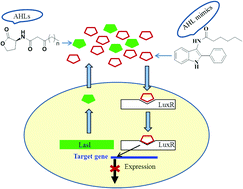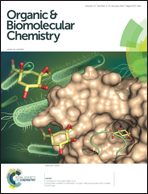Indole-based novel small molecules for the modulation of bacterial signalling pathways†
Abstract
Gram-negative bacteria such as Pseudomonas aeruginosa use N-acylated L-homoserine lactones (AHLs) as autoinducers (AIs) for quorum sensing (QS), a major regulatory and cell-to-cell communication system for social adaptation, virulence factor production, biofilm formation and antibiotic resistance. Some bacteria use indole moieties for intercellular signaling and as regulators of various bacterial phenotypes important for evading the innate host immune response and antimicrobial resistance. A range of natural and synthetic indole derivatives have been found to act as inhibitors of QS-dependent bacterial phenotypes, complementing the bactericidal ability of traditional antibiotics. In this work, various indole-based AHL mimics were designed and synthesized via the 1-ethyl-3-(3-dimethylaminopropyl)carbodiimide hydrochloride (EDC·HCl) and N,N′-dicyclohexylcarbodiimide (DCC) mediated coupling reactions of a variety of substituted or unsubstituted aminoindoles with different alkanoic acids. All synthesized compounds were tested for QS inhibition using a P. aeruginosa QS reporter strain by measuring the amount of green fluorescent protein (GFP) production. Docking studies were performed to examine their potential to bind and therefore inhibit the target QS receptor protein. The most potent compounds 11a, 11d and 16a showed 44 to 65% inhibition of QS activity at 250 μM concentration, and represent promising drug leads for the further development of anti-QS antimicrobial compounds.


 Please wait while we load your content...
Please wait while we load your content...